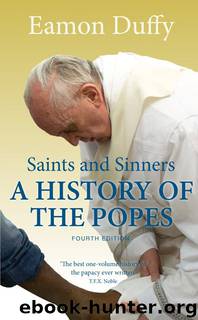Saints and Sinners: A History of the Popes; Fourth Edition by Eamon Duffy

Author:Eamon Duffy [Duffy, Eamon]
Language: eng
Format: epub
ISBN: 9780300115970
Publisher: Yale University Press
Published: 2015-01-12T22:00:00+00:00
II FROM RECOVERY TO REACTION
In the late summer of 1799, Italy was uneasily free of the French. The Roman Republic had collapsed and Neapolitan troops occupied Rome. All over the peninsula improvised armies of ‘Sanfedisti’ (from ‘holy faith’) had arisen in defence of religion and against Jacobinism. Venice, the Legations and virtually the whole of the papal territories north of Rome were in the hands of the Austrians. Pius VI had favoured Venice as the most suitable location for a conclave, and many cardinals were already gathered there when he died. The Emperor Francis II, confident that the cause of the papacy and the interests of Austria were bound to be the same, offered to pay the Conclave expenses. The cardinals duly assembled in the Benedictine island monastery of San Giorgio there on 30 November 1799, the first Sunday in Advent. The newly appointed secretary of the Conclave, Ercole Consalvi, had announced the death of Pius VI to the monarchs of Europe in terms which underlined the links between throne and altar: ‘Too many crowned heads, alas, in our times have seen that the princely power falls when the dignity of the Church decays. Restore the Church of God to her ancient splendour: then the enemies of the Crown will shake in terror.’2 That assumed convergence of interests would dominate the election.
The Emperor, paying the bills, was clear in his requirements. The new Pope need not be a man of talent or ability – a pope, after all, was never short of advisers. But Austria needed a pope who would throw the moral weight of the papacy behind the forces of European counter-revolution, against revolutionary France. Though he did not say so, Austria in particular needed a pope who would surrender the Legations and the rest of Austrian-occupied papal territory, as Pius VI had surrendered them to France at the Peace of Tollentino. By contrast, Naples demanded a pope committed to the restoration of the Papal States, who for that reason would be willing to co-operate in driving Austria out of the peninsula.
With the whole of Europe in flux, the Conclave sat deadlocked for three months. Eventually, however, a compromise candidate emerged, and the cardinals unanimously elected the ‘Citizen Cardinal of Imola’, the sweet-natured monk, Barnaba Chiaramonte. From Austria’s point of view this was a disaster. Chiaramonte, who took the name Pius VII (1800–23), was, like Pius VI, a native of Cesena in the Legations, and was bishop of the neighbouring see of Imola. He would never agree to Austrian sovereignty over this traditional papal territory. Moreover, everybody remembered his notorious ‘Jacobin’ Christmas sermon of 1797, in which he had baptised democracy. Here, in this mild-mannered man, who preferred to make his own bed and mend his own cassock, was a pope of decidedly unsound political views. To signal their displeasure, the Austrians refused the use of San Marco for the coronation, and Pius had to be crowned in the cramped monastery church, while the lagoon seethed with boatloads of spectators craning for a glimpse.
Download
This site does not store any files on its server. We only index and link to content provided by other sites. Please contact the content providers to delete copyright contents if any and email us, we'll remove relevant links or contents immediately.
| Buddhism | Christianity |
| Ethnic & Tribal | General |
| Hinduism | Islam |
| Judaism | New Age, Mythology & Occult |
| Religion, Politics & State |
Cecilia; Or, Memoirs of an Heiress — Volume 1 by Fanny Burney(32434)
Cecilia; Or, Memoirs of an Heiress — Volume 2 by Fanny Burney(31871)
Cecilia; Or, Memoirs of an Heiress — Volume 3 by Fanny Burney(31852)
The Secret History by Donna Tartt(18845)
Sapiens: A Brief History of Humankind by Yuval Noah Harari(14250)
Leonardo da Vinci by Walter Isaacson(13181)
The Radium Girls by Kate Moore(11921)
Sapiens by Yuval Noah Harari(5294)
How Democracies Die by Steven Levitsky & Daniel Ziblatt(5127)
The Wind in My Hair by Masih Alinejad(5033)
Homo Deus: A Brief History of Tomorrow by Yuval Noah Harari(4823)
Endurance: Shackleton's Incredible Voyage by Alfred Lansing(4676)
The Silk Roads by Peter Frankopan(4457)
Man's Search for Meaning by Viktor Frankl(4423)
Millionaire: The Philanderer, Gambler, and Duelist Who Invented Modern Finance by Janet Gleeson(4374)
The Rape of Nanking by Iris Chang(4137)
Joan of Arc by Mary Gordon(4013)
The Motorcycle Diaries by Ernesto Che Guevara(4012)
Hitler in Los Angeles by Steven J. Ross(3900)
